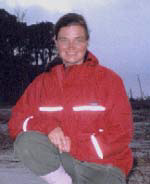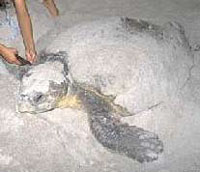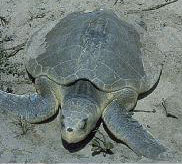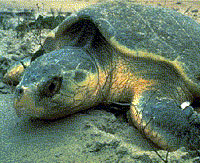Kris Williams is the “Turtle Babe” of Wassaw Island. At 33, the attractive, square-jawed blonde heads the oldest volunteer-based sea turtle conservation project in North America.

What a babe.
Optimism comes as naturally to Williams as the tide comes to the beach. It has to, because sea turtle conservation in Georgia isn’t easy.
“Awareness is higher than it’s ever been and that gives me hope,” Williams said. “Conservation programs are rampant, particularly in Third World countries where there were none before, and that gives me hope.””
The Caretta Research Project — named for the caretta caretta, a threatened loggerhead sea turtle species — has been watching over sea turtles on Wassaw Island National Wildlife Refuge, a Georgia barrier island, for 28 years. Williams and the project won the National Oceanic and Atmospheric Administration’s (NOAA) Environmental Hero Award for 2000 and are credited by Georgia wildlife officials with helping keep Georgia sea turtle populations from crashing.
Not too bad for a sometimes shoestring effort that has often gotten by on little more than good will and wishful thinking. The museum that originally sponsored the Caretta Research Project closed its doors several years ago. The project now stands alone, willed on by Williams — who, to make ends meet, works at Victoria’s Secret on the side — some board members, and devoted volunteers.

A loggerhead turtle gets a helping hand.
USFWS.
The project’s many volunteers buoy the Turtle Babe’s spirits. More than 2,000 people have pitched in over the years, paying their own way for the privilege of working with nesting loggerheads for a week at a time. By moonlight they patrol the beaches for turtles; by daylight they try to sleep in sweltering rustic cabins. A number of them come back year after year. Seduced by sea turtles, some even end up moving to coastal Georgia.
“This is not just for us,” Mike Frick, assistant director of the project, said of the NOAA award. “It’s for all the volunteers, the former directors, all the people who help year after year.” Frick started with the project as a teenager 14 years ago. He, like some other project volunteers, turned to a career in biology after spending time on Wassaw.
Fins Sins
Georgia’s sea turtles had a pretty good year in 2000, with a total of 1,070 confirmed nests, below 1999’s record-breaking 1,417, but nothing to cry about, Williams said. And fewer turtles washed up dead on Georgia beaches this year than last — 155 versus 269.

Kemp’s ridley sea turtle, fins intact.
David Bowman, USFWS.
Still, one of the deceased turtles that did wash up challenged even Williams’s optimism. It was a highly endangered Kemp’s ridley sea turtle, well-fed but with its fins cut off, perhaps by hostile fishers who caught it by accident.
And the number of strandings on beaches can be a poor indicator of what is really happening to sea turtles, said Mark Dodd, a wildlife biologist with the Georgia Department of Natural Resources. “The lower numbers could be a result of fewer turtles around, reduced fishing and shrimping efforts, or simply a factor of prevailing winds washing the dead ones out rather than in,” Dodd said. Several studies have shown that only about 10 percent of turtles that die actually wash ashore and are counted.
Despite high compliance with U.S. regulations that require shrimpers to use turtle excluder devices (TEDs), which help turtles escape from shrimping nets, repeated captures in these nets are still thought to be the leading cause of sea turtle mortality. However, use of newer TEDs seems to helping, Dodd said — and this is the type of positive development that Williams likes to point to.
“There are fishermen out there just as concerned about the ocean as we are,” Williams said. “I always try to remember the many good ones.”
Nice T-shirt!
When she was in college in New York, Williams wanted to study marine mammals. One summer while working in a Long Island grocery store, a customer walked in with a turtle conservation T-shirt on. Williams liked it. She talked the customer into giving her a summer internship with the Okeanos Conservation Project tracking Kemp’s ridley turtles in Long Island Sound. She never looked back to marine mammals, and she worked her way to the Caretta Research Project, which she has now managed for four years.

The turtle’s all right (maybe).
USFWS.
The recent approval by President Clinton and the U.S. Senate of an innovative treaty to protect six turtle species, the Inter-American Convention for the Protection and Conservation of Sea Turtles, came as no surprise to Williams. Of course the president would do the right thing by her beloved sea turtles, Williams reasons. Who wouldn’t?
Despite some good news this year, it’s still hard to say how Georgia’s sea turtles are faring overall. Turtles nest in cycles of about four years’ duration with a couple of peaks and lows in each cycle, making it hard to see population gains or losses.
While some turtle projects, like the one on Wassaw, are long-lived, others are not. Dodd said he has 12 years of data for the state as a whole and will need 16 years worth to discern a significant swing in the turtle population one way or the other. The best information available now indicates that Georgia’s sea turtle population is holding steady, at numbers about half of what they were 40 years ago.


